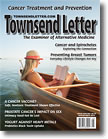Page 1, 2, 3
Milman found that low IGF-1 levels as useful in predicting longevity.50 For women in their 90s, those with IGF-1 below the group's median lived longer than those with above average levels. In elderly men, in contrast to the women, low IGF-1 is associated with increased mortality. High circulating IGF-I bioactivity in old men is associated with extended survival because of reduced cardiovascular risk.51
A third paper has also been on my mind, particularly when speaking with breast cancer patients, since it was published in April 2014. This is Jennifer Emond's landmark paper on breast cancer, IGF-1-receptor status, and diet. Emond's team compared the effect of decreased carbohydrate consumption on breast cancer recurrence rates in women whose tumors were classified as either positive or negative for IGF-1-receptors (IGFR). Receptor status made a significant difference in their outcome.
Dietary carbohydrate intake had no significant effect on women whose tumor cells were IGF-1-receptor negative, but for women who were positive, it made a huge difference. Those women, who maintained the same level or increased their carbohydrate intake, had over a 5-fold increased risk of recurrence. For these IGF-1 receptor positive women, lowering carbohydrate intake was associated with an 80% decreased risk of recurrence. Emond considered a 10% reduction in calories from carbohydrates as "low carb."52 Dietary interactions, particularly with carbohydrates, may be the missing piece of the IGF puzzle.
Few evaluations of the impact that IGF pathways have on cancer have included the effect of insulin. This perhaps, was a mistake. Insulin-like-growth factors not only look and act like insulin structurally but there is a great deal of what scientists call crosstalk between the receptors that these hormones bind to. Insulin and IGF-1 bind to each other's receptors. Insulin receptors (IR) are also overexpressed in cancers and they form hybrid receptors that are a cross between IGFR and IR so that both insulin and IGF-1 will activate them.53 Insulin itself becomes a potent growth factor promoting cancer proliferation. High insulin levels also increase the bioactivity of IGF-1 by inhibiting IGF binding protein-1.54
This annoyingly complex group of interactions between the different forms of insulin, IGF and IR and IGF-receptors all act together influencing behavior of cancer cells, their growth rate, and their tendency toward apoptosis.55
This could explain the inconsistencies in data seeking direct correlation between any one of these hormones and cancer outcome and also the modest outcomes reported only using antibody drugs that target only IGF-receptors.56
As we often find in biology, few of the actors are all good or all bad. While stimulation of IGF-1-receptors may have an unwanted impact on cancer and longevity, IGFs still play an important role in keeping people alive. IGF-1 is important in maintaining healthy vasculature (particularly when vitamin D levels are low), cognitive function, and bone architecture.57 Thus we may actually want to increase IGF-1 levels in particular situations. IGF-1 protects the brain from aging and neurodegeneration; reduces risk of stroke, dementia, and Alzheimer's disease; helps stroke patients recover faster; and prevents osteoporosis.58-62
There are clearly times when our goal should be to increase IGF levels and IGF-receptor activation. For preventing and slowing cancer growth though, our goal is clearly the opposite.
It should be mentioned somewhere that lowering IGF-1 through short-term fasting is a well-known way to reduce the side effects of chemotherapy.63 Lowering IGF-1 during chemotherapy, and possibly radiation, may also enhance treatment effectiveness.64
At this point the best-documented way to lower IGF-1 is through caloric restriction.65-67 Reducing animal protein consumption, as mentioned, also lowers IGF-1.68 In humans, reducing protein consumption actually lowers IGF-1 more effectively than caloric restriction. Interestingly, moderate protein restriction appears more effective than severe restriction in reducing total and free IGF-1 levels. Reducing protein intake from an average of 1.67 to 0.95 g/kg/ body weight/day for 3 weeks reduced serum IGF-1 from 194 ng/mL to 152 ng/mL.69
High-protein diets will not increase IGF during total energy deficit.70 That is, any diet without adequate calories to maintain weight will not raise IGF-1. Following a Mediterranean-style diet, particularly one with less meat, also lowers IGF-1.71
Milk and whey protein consumption increases IGF-1 significantly.72,73 This might explain milk's association with prostate cancer.
Metformin, the drug commonly used to treat type 2 diabetes, may be useful against cancer in part because it lowers IGF-1 through "the activation of the AMP-activated protein kinase (AMPK) … leading to reduced circulating insulin levels and decreased insulin/IGF-1 receptor-mediated activation of the PI3K pathway." Metformin increases insulin sensitivity lowering insulin levels. Hyperinsulinemia, as mentioned, increases the bioactivity of IGF-1 by inhibiting IGF binding protein-1.74
IGF-1 maintains bone health and, not surprisingly, some of the factors used to increase bone density also increase IGF-1 levels.75 Diets high in dried plums (i.e., prunes) increase bone density by increasing IGF-1.76,77 Vitamin D increases IGF-1 levels in adults.78 Curiously, proton pump inhibitors sharply lower IGF-1.79 (These drugs increase bone fracture risk, and the past assumption was that they interfered with calcium absorption. Perhaps it is their effect on IGF-1 levels that weakens bone?)
At this point information on IGF pathways is less clear cut than we might wish, but for cancer patients our focus should clearly be on reducing IGF-1 bioactivity. Caloric restriction, intermittent fasting, animal protein reduction (particularly dairy protein), and making food choices modeled after a Mediterranean diet will help do this. Preventing hyperglycemia and hyperinsulinemia by reducing carbohydrates may also be key to seeing benefits; the less IGF-1 and the less insulin, the better.
IGF-1 chemistry and insulin cross-talk is cutting-edge biochemistry, but the bottom line remains close to what we naturopathic doctors have traditionally told our patients to do: cut down on animal protein, especially dairy; decrease sugar and simple carbohydrates; lose weight; exercise; and follow a Mediterranean-style diet.

Ways to Lower IGF-1
• Fasting
• Caloric restriction80
• Reduce animal protein
• Decrease milk and whey proteins81
• Mediterranean diet82
• Proton pump inhibitors83
• EGCG84
• Metformin85
• Curcumin86
IGF-1 Is Not All Bad
There are situations in which increasing IGF-1 is advantageous. As mentioned, using drugs to block IGF-1 activity leads to problems. That's because we need IGF-1 to maintain healthy vasculature, cognitive function, and bone strength.
We may want to increase IGF-1 to treat neurodegeneration, stroke, CVD, Alzheimer's disease, osteoporosis, and injury.87-91
Ways to Increase IGF-1
• Prunes92
• Deer antler93
• Meat
• Protein: any94
• Methionine95
• Milk and whey proteins96

 Jacob Schor, ND, FABNO, has practiced as a naturopathic physician in Denver, Colorado, with his wife, Rena Bloom, ND, since they graduated from National College of Naturopathic Medicine in 1991. He was humbled in 2008 when presented with the Vis Award by the American Association of Naturopathic Physicians (AANP). He has had the honor of serving the members of the Oncology Association of Naturopathic Physicians as a board member and currently as president. Dr. Schor began a term on the AANP's board of directors in January 2012. He is a frequent contributor to, and associate editor of, the Natural Medicine Journal. Jacob Schor, ND, FABNO, has practiced as a naturopathic physician in Denver, Colorado, with his wife, Rena Bloom, ND, since they graduated from National College of Naturopathic Medicine in 1991. He was humbled in 2008 when presented with the Vis Award by the American Association of Naturopathic Physicians (AANP). He has had the honor of serving the members of the Oncology Association of Naturopathic Physicians as a board member and currently as president. Dr. Schor began a term on the AANP's board of directors in January 2012. He is a frequent contributor to, and associate editor of, the Natural Medicine Journal.
Page 1, 2, 3 |
![]()
![]()
![]()





 Jacob Schor, ND, FABNO, has practiced as a naturopathic physician in Denver, Colorado, with his wife, Rena Bloom, ND, since they graduated from National College of Naturopathic Medicine in 1991. He was humbled in 2008 when presented with the Vis Award by the American Association of Naturopathic Physicians (AANP). He has had the honor of serving the members of the Oncology Association of Naturopathic Physicians as a board member and currently as president. Dr. Schor began a term on the AANP's board of directors in January 2012. He is a frequent contributor to, and associate editor of, the
Jacob Schor, ND, FABNO, has practiced as a naturopathic physician in Denver, Colorado, with his wife, Rena Bloom, ND, since they graduated from National College of Naturopathic Medicine in 1991. He was humbled in 2008 when presented with the Vis Award by the American Association of Naturopathic Physicians (AANP). He has had the honor of serving the members of the Oncology Association of Naturopathic Physicians as a board member and currently as president. Dr. Schor began a term on the AANP's board of directors in January 2012. He is a frequent contributor to, and associate editor of, the